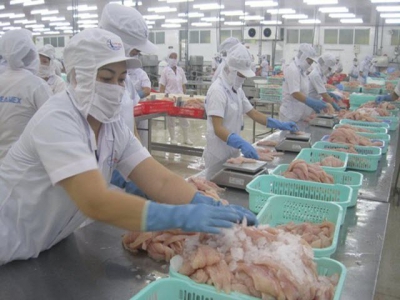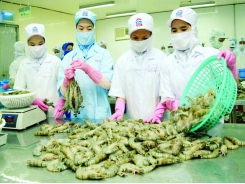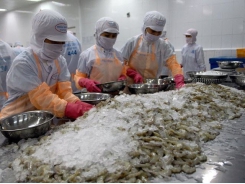Seafood exports difficult in short term

HANOI - Though a bright outlook is forecast for seafood exports in the long term, export activities in the short term are meeting with difficulties, especially in U.S. and EU markets.
Tra fish fillet processing at a factory in the Mekong Delta. In the short term, seafood exports are meeting with difficulties, especially in U.S. and EU markets - PHOTO: TRUNG CHANH
According to the Ministry of Industry and Trade’s Export-Import Department, the turnover of seafood exports was some US$700 million last May, up 2.3% against the previous month and equivalent to that of May 2017. In January-May, seafood exports reached US$3.1 billion, a year-on-year rise of 11%.
Though seafood exports have continuously increased, there are many risks in major markets. In the U.S. market, many firms have had to leave the market due to trade barriers.
According to the Vietnam Association of Seafood Exporters and Producers (VASEP), early this year there were some 14 firms exporting to the U.S., but only three have remained in the market.
Further, Vietnamese shrimp is subject to the U.S.’ seafood import monitoring program, causing the market share of Vietnamese shrimp to drop to 6.8% in the year’s first three months.
As for the EU market, Vietnamese seafood products have been issued a yellow card, and hence all shipments to this market are held for inspection for their origins. Similarly, tiger prawn exports to China are also experiencing difficulties due to risks to exports at border crossings.
Given this, seafood exporters are remaining positive about the long term, as expressed at the national meeting on technical solutions for fish feed production on July 20.
The fisheries sector targets to contribute 2.8-3% to the nation’s gross domestic product (GDP) in 2020, with an export turnover of US$11 billion.
Seafood volumes last year were recorded at 7.22 million tons, with fishing accounting for 3.98 million tons and aquaculture 3.83 million tons. Additionally, 2017 seafood exports were US$8.3 billion.
Of note, growth of the sector will entail large demands for fish feed. In aquaculture, feed makes up 40-70% of production costs.
Last year, there were 218 industrial fish feed production facilities, with combined capacities of over 31 million tons. Some 18.1 million tons of fish feed materials valued at US$5.5 billion were imported.
Có thể bạn quan tâm
Phần mềm

Phối trộn thức ăn chăn nuôi

Pha dung dịch thủy canh

Định mức cho tôm ăn

Phối trộn phân bón NPK

Xác định tỷ lệ tôm sống

Chuyển đổi đơn vị phân bón

Xác định công suất sục khí

Chuyển đổi đơn vị tôm

Tính diện tích nhà kính

Tính thể tích ao hồ



 Sharp rise in imports of seafood
Sharp rise in imports of seafood  Eco-shrimp farming – model for sustainable aquaculture development
Eco-shrimp farming – model for sustainable aquaculture development